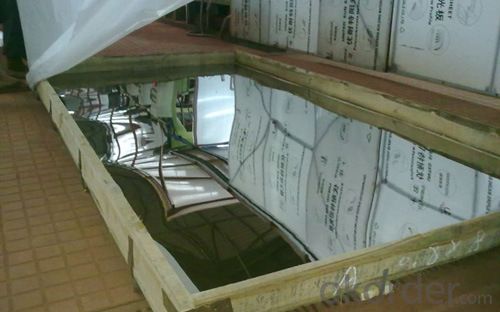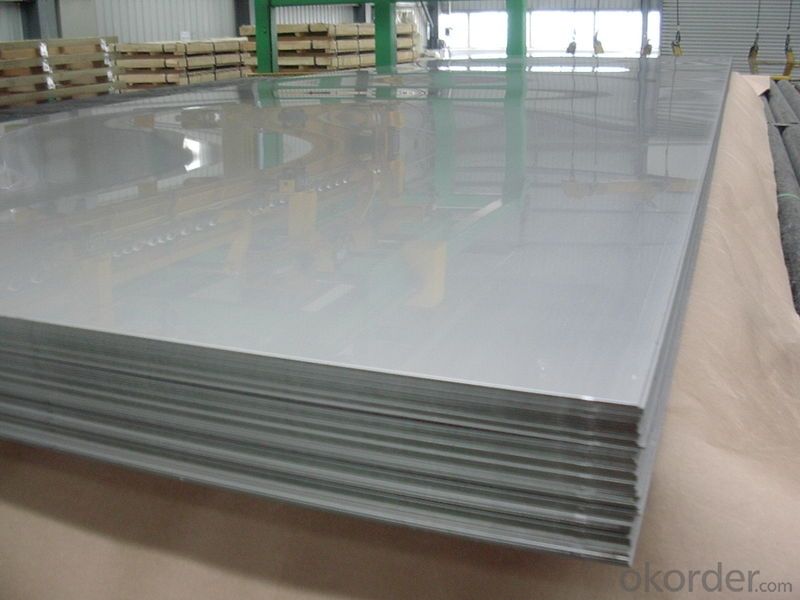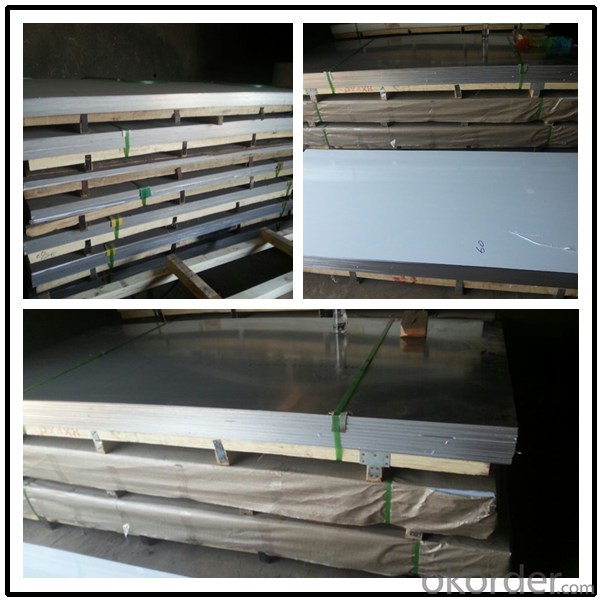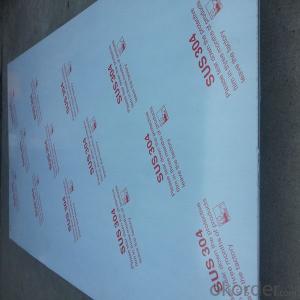Factory price 304L stainless steel sheet
- Loading Port:
- Shanghai
- Payment Terms:
- TT OR LC
- Min Order Qty:
- 5 m.t.
- Supply Capability:
- 3000 m.t./month
OKorder Service Pledge
OKorder Financial Service
You Might Also Like
Item specifice
Factory price 304L stainless steel sheet !!!
1.hot rolled and cold rolled stainless steel sheet detailed information:
Type | 304L stainless steel sheet |
Thinckness | 0.3mm-60mm |
Widthness | 50mm~2000mm |
Length | 2000mm~8000mm or as request |
Brand name | TISCO |
Standard | JIS, AISI, ASTM, GB, DIN, EN |
Material | 304L,304,316,316L,309S,310S,321,317,301,904L,201,202,430,410,420, etc |
Surface | 2B,BA,HL,BK,NO.1,NO.4,etc |
Certificate | We accept the third inspections |
Application | Bridge, Shipbuilding,roofing,Car, etc |
Payment | T/T, 30% deposit, blance before loading, L/C |
Note | We can produce other standard as the customers’ require |
2. 304L stainless steel sheet Applications :
| Finish | Thickness | Characteristics | Applications |
| No. 1 | 3.0mm~50.0mm | Finished by hot-rolling, annealing and pickling, characterized by white pickled surface | Chemical industry equipment, Industrial tanks |
| No. 2B | 0.3mm~6.0mm | Finished by heat treatment, pickling after cold rolling, followed by skin pass line to be more brighter and smooth surface | General Application Medical Instruments,Tableware |
| No. BA (Bright Annealed) | 0.5mm~2.0mm | Bright heat treatment after cold rolling | Kitchen utensil, kitchen ware,architectural purpose |
| No. 4 | 0.4mm~3.0mm | Polishing with No. 150 to No.180 mesh abrasivesThe most popular finishes | Milk & Food processing acilities, Hospital Equipment, Bath-tub |
| HL(Hair Line) | 0.4mm~3.0mm | Finished by continuous linear polishing | Architectural purposes, escalators, kitchen ware vehicles |



Why do you choose us?
1) Our products are high quality and best price.
2)We have experience in this line for many years.
3)We have professional team and the factory.
4)It's very important for a company to be honest in the process of trading and so do we.

- Q:What is the difference between 316 and 316Ti stainless steel pipes?
- The main difference between 316 and 316Ti stainless steel pipes is the addition of titanium (Ti) in 316Ti. This titanium content makes 316Ti more resistant to corrosion and sensitization at elevated temperatures, making it suitable for applications where the pipes will be exposed to high temperatures. 316 stainless steel, on the other hand, does not contain titanium and is more commonly used for general-purpose applications.
- Q:What are the different types of stainless steel pipe nipples?
- There are several different types of stainless steel pipe nipples available, each designed for specific applications and industries. 1. Seamless Stainless Steel Pipe Nipples: These are made from a single piece of stainless steel, without any welded joints. They are known for their high strength and ability to withstand high pressure and temperature. 2. Welded Stainless Steel Pipe Nipples: These are created by joining two or more pieces of stainless steel using a welding process. They are more cost-effective than seamless nipples but may have lower strength and durability. 3. Threaded Stainless Steel Pipe Nipples: These nipples have threaded ends, allowing them to be easily screwed into place. They are commonly used in plumbing and other applications where easy installation and removal is required. 4. Square Stainless Steel Pipe Nipples: These nipples have a square shape rather than the traditional cylindrical shape. They are often used in structural applications where stability and strength are important. 5. Hex Stainless Steel Pipe Nipples: These nipples have hexagonal ends, which provide a greater grip for tightening and loosening. They are commonly used in plumbing and gas supply systems. 6. Close Nipples: These are short-length stainless steel pipe nipples with threaded ends on both sides. They are used to connect two fittings directly without any gap. 7. King Nipples: Also known as hose nipples, these stainless steel pipe nipples have a male threaded end on one side and a barbed end on the other side. They are commonly used in hose assemblies for fluid transfer. 8. Reducing Nipples: These stainless steel pipe nipples have different diameters on each end, allowing for connection between pipes of different sizes. 9. Swage Nipples: These are stainless steel pipe nipples that have one end with a larger diameter than the other. They are used to transition between pipes of different sizes. 10. PEX Nipples: These are specifically designed stainless steel pipe nipples for use with PEX (cross-linked polyethylene) tubing in plumbing systems. They have barbed ends that securely connect to the PEX tubing. Overall, the choice of stainless steel pipe nipple depends on the specific application requirements such as pressure, temperature, compatibility with fluids, and installation method.
- Q:Can stainless steel pipes be insulated with polyurethane?
- Yes, stainless steel pipes can be insulated with polyurethane. Polyurethane insulation is commonly used for both thermal and acoustic insulation in various industries, including plumbing and HVAC systems. It offers excellent thermal conductivity properties and low moisture absorption, making it an ideal choice for insulating stainless steel pipes. Polyurethane insulation can be applied as a foam or in the form of pre-insulated pipe sections. It provides effective insulation by reducing heat loss or gain, preventing condensation, and improving energy efficiency. Additionally, polyurethane insulation is durable, lightweight, and resistant to corrosion, making it a suitable choice for insulating stainless steel pipes in various applications.
- Q:What is the difference between 304Cb and 316Cb stainless steel pipes?
- The main difference between 304Cb and 316Cb stainless steel pipes lies in their chemical composition and their respective properties. 304Cb stainless steel is an austenitic stainless steel alloy that contains chromium and nickel. It also has a small amount of niobium, which enhances its resistance to intergranular corrosion. This makes 304Cb stainless steel pipes suitable for a wide range of applications, including food processing, chemical and petrochemical industries, and architectural purposes. On the other hand, 316Cb stainless steel is also an austenitic stainless steel alloy that contains chromium and nickel. However, it has a higher percentage of molybdenum, which gives it superior resistance to corrosion and pitting in chloride environments. This makes 316Cb stainless steel pipes ideal for applications where exposure to saltwater or other corrosive substances is common, such as marine environments or coastal areas. In summary, while both 304Cb and 316Cb stainless steel pipes are excellent choices for various applications, 316Cb stainless steel offers better corrosion resistance in chloride environments due to its higher molybdenum content. Depending on the specific needs and environment of the application, one may be more suitable than the other.
- Q:Mirror stainless steel tube 60*60 how much is one meter?
- Examples are stainless steel 63 round tubes, solid thickness 0.82 stainless steel tubes, single support 6 meters long, weight (63-0.82) *0.82*0.02491*6=7.62kg, a six meter long 63 round tube, thickness 0.82, theoretical weight is 7.62kg;
- Q:Can stainless steel pipes be used for dairy processing equipment?
- Indeed, dairy processing equipment can utilize stainless steel pipes. Stainless steel is widely favored in the food and beverage sector owing to its remarkable resistance to corrosion, hygienic qualities, and long-lasting nature. Its exceptional ability to ward off rust, stains, and contamination renders it highly suitable for employment in dairy processing equipment, where cleanliness and food safety are of utmost importance. Furthermore, stainless steel pipes possess the capability to endure elevated temperatures and pressures, which are frequently necessary in dairy processing operations. All in all, stainless steel pipes prove to be a dependable and appropriate material for incorporation in dairy processing equipment.
- Q:Can stainless steel pipes be used for structural purposes?
- Yes, stainless steel pipes can be used for structural purposes. Stainless steel is known for its strength and durability, making it suitable for various structural applications such as construction, infrastructure, and industrial projects. Its corrosion resistance properties also make it a preferred choice for environments that are exposed to moisture or chemicals.
- Q:What is the difference between Schedule 10 and Schedule 40 stainless steel pipes?
- The main difference between Schedule 10 and Schedule 40 stainless steel pipes lies in their wall thicknesses and pressure ratings. Schedule 10 pipes have thinner walls compared to Schedule 40 pipes. This means that Schedule 10 pipes are suitable for applications that require lower pressure ratings and are generally used for lighter-duty purposes. On the other hand, Schedule 40 pipes have thicker walls, making them suitable for applications that require higher pressure ratings and are often used in heavy-duty or industrial settings. The choice between Schedule 10 and Schedule 40 stainless steel pipes depends on the specific requirements of the application, including the pressure, temperature, and material compatibility.
- Q:What's the difference between stainless steel decorative pipes and polished stainless steel pipes?
- Stainless steel decorative tubes are mainly used for decoration, such as railings, staircases, hand guards, railings, windows and so on, the wall thickness is very thin,Polished stainless steel pipe is not the same, the industry can also be used, that is, just made out, some rough, not smooth, so polished under the smooth, according to customer needs.
- Q:Can stainless steel pipes be used for oil pipelines?
- Indeed, oil pipelines can utilize stainless steel pipes. Renowned for its exceptional resistance to corrosion, stainless steel is an ideal material for the transfer of diverse fluids, such as oil. Moreover, its durability and ability to withstand high pressure and temperature circumstances further enhance its suitability for oil pipelines. Additionally, the smooth inner surface of stainless steel pipes aids in diminishing friction and enhancing the oil's flow. Nevertheless, it is vital to carefully contemplate the selection of stainless steel grade and appropriate coating to guarantee compatibility with the specific type of oil and the prevailing environmental conditions in which they will be employed.
1. Manufacturer Overview |
|
|---|---|
| Location | |
| Year Established | |
| Annual Output Value | |
| Main Markets | |
| Company Certifications | |
2. Manufacturer Certificates |
|
|---|---|
| a) Certification Name | |
| Range | |
| Reference | |
| Validity Period | |
3. Manufacturer Capability |
|
|---|---|
| a)Trade Capacity | |
| Nearest Port | |
| Export Percentage | |
| No.of Employees in Trade Department | |
| Language Spoken: | |
| b)Factory Information | |
| Factory Size: | |
| No. of Production Lines | |
| Contract Manufacturing | |
| Product Price Range | |
Send your message to us
Factory price 304L stainless steel sheet
- Loading Port:
- Shanghai
- Payment Terms:
- TT OR LC
- Min Order Qty:
- 5 m.t.
- Supply Capability:
- 3000 m.t./month
OKorder Service Pledge
OKorder Financial Service
Similar products
New products
Hot products
Hot Searches
Related keywords




























